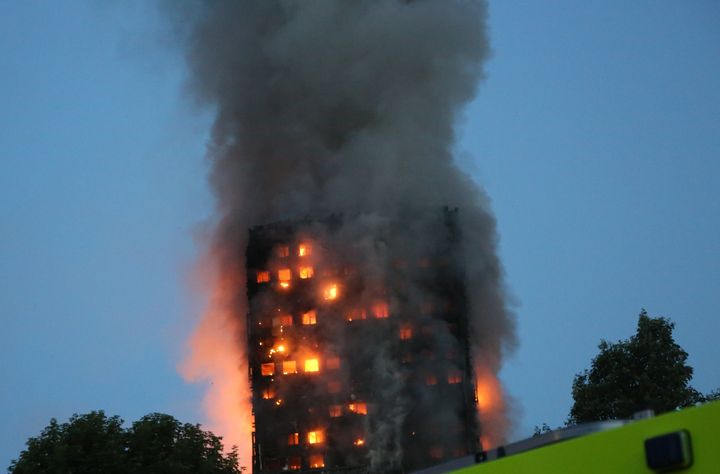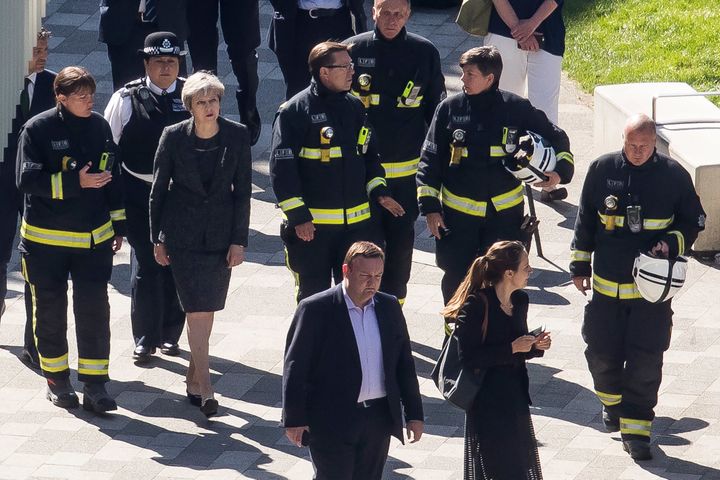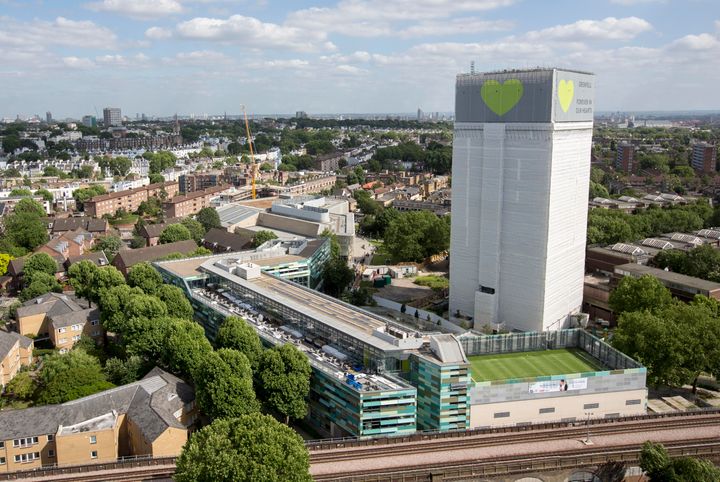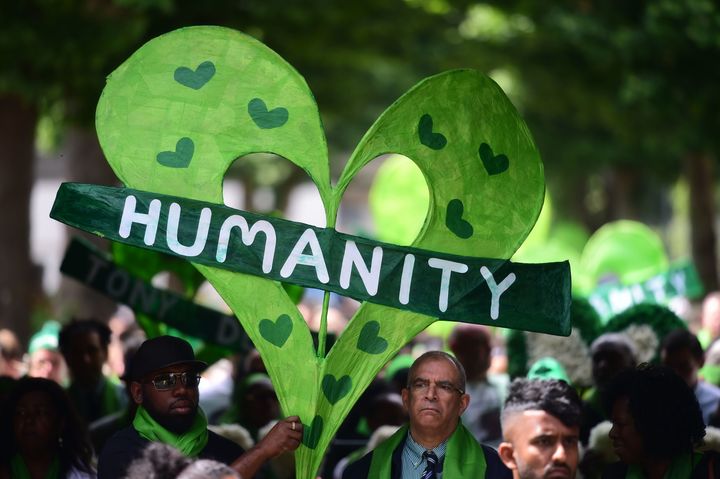
The head of the London Fire Brigade has described how the events of the Grenfell fire affected her, resulting in lasting trauma-related memory blanks.
Commissioner Dany Cotton said she still has trouble talking about the June 2017 incident, which claimed the lives of more than 70 people, or looking at images of the inferno.
In a written statement read to the public inquiry into the disaster on Thursday, Cotton said she had issues with her memory which she believed were “linked to the traumatic nature and sheer scale” of the fire.
She said: “I have subsequently undergone an accredited counselling technique called EDMR with a view to improving my memory recall.”
This had not been “terribly successful”, Cotton said.
She continued: “I’m still finding it very difficult to look at visual images and have conversations about Grenfell.
“I’m still responsible for effectively running the London Fire Brigade, and everything else that’s involved in that. It would be no good for me to fall apart.
“Therefore, I have not spent huge amounts of time in my head looking and thinking about Grenfell Tower.
“In speaking to police to provide this statement, this will actually be the first time I have talked through the whole incident.”

The Commissioner described the moment she arrived at Grenfell Tower at 2.49am.
She said in the statement: “Sitting in my car I could see the tower through my front windscreen. I was still on the phone to Tom [LFB director of operations] and said ‘What the f***? This can’t actually be happening; I can’t believe what I’m seeing’.
“It just looked like something from a disaster movie. Like a hideous mixture of ‘Towering Inferno’ and a video I was shown in training school of a high-rise fire in Sao Paulo where people jumped to escape.
“I think I said that in as many words to Tom and he just said ‘I won’t keep you, you need to go, I’ll speak to you later’.
“So my first words about Grenfell Tower were down the phone to him, and most of them consisted of the ‘F’ word.”
Cotton said she first went into the tower to reassure and comfort firefighters because she did not know if they would all return from the blaze alive.
“I recall I actually physically went and touched some firefighters when I spoke to them, because I was not a hundred percent convinced in my mind that everybody was going to come out of there alive,” her statement revealed.
“The building was so hugely involved in fire; you cannot help but compare it to 9/11.”
She added: “I wanted those firefighters to have a positive reinforced memory before they went into the building of somebody saying nice things to them, being supportive and demonstrating to them that somebody really cared.”

Later, Cotton said she was hit by overwhelming anxiety to be sending firefighters into a situation where she could not give any assurances on their safety.
She said: “The imperative was to save human life. The right to life is a basic function of human rights and we were servicing that human right.
“However, for the first time ever, I had an overwhelming continuous feeling of anxiety, of responsibility in committing firefighters into a building where I could not guarantee their safety.
“I’ve never felt that way before, and I have been in charge at hundreds of large scale operational incidents.
“It was a huge responsibility to know how many people were in there and that we were just going to keep committing and committing – even though there was a potential risk – but that was the decision we took.”
The Commissioner also revealed she had blocked out the memory a near-miss involving falling debris which a fellow officer thought could have killed her.
She said she believed her brain was “protecting me” from the reality of the night, when an operational colleague Matt Cook said she was almost hit by a six-foot piece of debris.
She said: “Matt Cook says we had a conversation at the time which went something along the lines of ‘That was really close, that nearly got you’.
“Apparently I had laughed and said ‘But it didn’t’. Matt was very traumatised by it because he thought I was going to die, but I have no recollection of it whatsoever.
“The amount of debris that was coming down from the outside of the building was indescribable. It was like being under attack whilst trying to do your job.”
Cotton said an incident such as the June 14 blaze would have been deemed an “unrealistic scenario”.
“The complete failure of a building, the ability for a fire to spread across the external face of a building, for it so involve so many people, for it to involve as many fire survival guidance calls, I could go on...,” her statement said.
Cotton told the inquiry – set up by the government to examine in detail the circumstances surrounding the disaster – that would have been told “to stay in their flat” by control room officers if there was no direct risk to them, such as flames or smoke.
She added that if “a building behaves correctly” then the “stay put” advice is the safest option.
The inquiry, chaired by Sir Martin Moore-Bick, previously heard evidence around the failure of LFB’s “stay put” policy, equipment shortages, inadequate training and faulty radio communications.
Cotton said she did not receive training on fire-spread over the facade of a high rise residential block.
“I only received training for looking at fire-spread in things like sandwich panels, but not in a residential block,” she added.

She also said she had never received any training on cladding or the spread of fire on cladding.
The fire chief acknowledged the importance of the police investigation and public inquiry following the “unprecedented” tragedy.
But she said the brigade “should never have been put in that position to have responded to that incident in that way”.
She added: “It has truly damaged some people who witnessed some terrible things and who will never forget them. They will wear the scars for the rest of their life.
“I did not know for quite a long time whether that building was going to stay up. I did not know whether I was going to end up having to report back to say that (a) firefighter had been seriously injured or worse.
“People will quite rightly have questions, but for me I could not be more proud of the absolute commitment and dedication of the firefighters.
“They were clearly terrified of going into Grenfell Tower.”
Cotton, the most senior officer to speak at the public inquiry so far, said the London Fire Brigade “do expect the unexpected” but would not make plans for a “space shuttle to land in front of the Shard”.
When questioned about how prepared officers were to tackle the blaze, she said: “I wouldn’t develop a training package for a space shuttle to land in front of the Shard.
“We would respond to it and deal with it in the same manner we do an incident of that scale.
“I wouldn’t expect us to be developing training or a response to something that simply shouldn’t happen.”

Ms Cotton was questioned on the brigade’s use of the “stay put” policy at Grenfell Tower.
Questioned on why she did not ask officers upon arriving to the scene why the advice to residents had not been changed earlier, she said: “At that moment in time it was far more important to collect the information with the ongoing situation.
“The priority at that point was to save life.”
When questioned about why the “stay put” policy was not revoked earlier, Ms Cotton said it was due to the “very narrow” single staircase evacuation route.
She said: “People were trapped by smoke and it would’ve added to congestion on the stairwell. Bringing people out at that moment in time would have added to the casualties and delayed the response.”
When pressed further by Mr Millett on the “stay put” policy, Ms Cotton said: “I think I’ve just explained it but I’m happy to go through it again, if you like, about why it wasn’t revoked.”
The inquiry continues.
